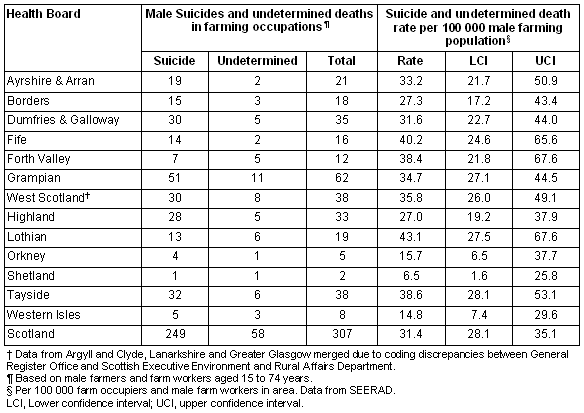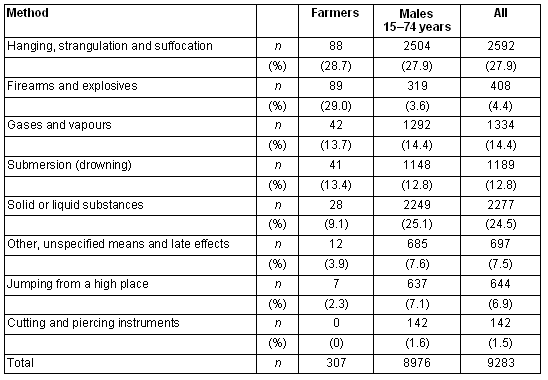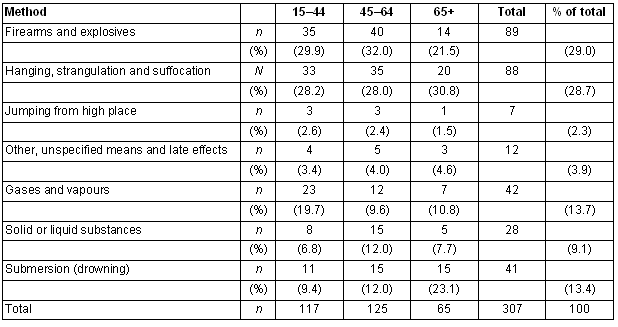Introduction
Farmers in England and Wales have a higher proportion of deaths from suicide than would be expected in comparison with men of the same age1,2. Detailed descriptions of farming suicide have been produced for England and Wales3-6. Some rural areas of Scotland have higher than average rates of suicide and undetermined death in men7,8, and choice of self-harm method, including firearm use, may contribute to this7-9. Malmberg et al.3 in a case-control study, found that farmers dying by suicide were more likely to work alone, and to have smaller social networks, than control farmers. A second study using routine data found no association with type of farming or proportion of farmers in an area in England and Wales6. This study sets out to find if the excess of deaths in farmers is confined to any particular areas or type of farming areas in Scotland, how it relates to male death rates in the same area, and whether any particular method of suicide was favoured by farmers in Scotland.
Methods
Anonymised routinely collected information on deaths provided by the General Register Office for Scotland (GROS) was used for the study. The study population was all men dying by suicide or undetermined intent in Scotland (ICD-9 E950-E959 and E980-E989 respectively) between the years 1982 and 1999 in people aged 15 to 74 years who were in an occupation related to farming or farm working. This included ICD occupations codes 107, 166 and 172 for deaths between 1982 and 1989 inclusive, and codes 042, 043, 434 and 436 for deaths after 1989.
Data for numbers of farm occupiers and male farm workers were obtained from Scottish Executive Environment and Rural Affairs Department (SEERAD) by year from 1982 to 1999, and all full time occupiers, part time occupiers and farm workers were used in the denominator for calculating suicide rates for the occupations of interest. Data for types of farm holdings were also obtained from the SEERAD for 1992. The year 1992 was used because this was the earliest data available for farm holdings, and was in the middle of the period. The NHS areas used for death records were smaller than the areas used by SEERAD. The NHS areas were combined in the analysis to be coterminous with the larger agricultural areas.
For the general male population, population figures were taken from the General Register Office for Scotland (GROS) annual reports for the mid-year of each period. Previous research in Scotland found that people sometimes traveled to other parts of Scotland, apparently in order to kill themselves9. This can affect rates in small populations. For analyses by area, if a death was registered away from the person's home address, the death was allocated to their area of residence, rather than the area in which they died. Deaths of people resident outside Scotland were identified using country codes, and were excluded. Rates were standardised against the Scottish male population structure.
Method of suicide was identified from the ICD codes on the GROS death records, and compared to methods of suicide and undetermined death in the male population in the same age range. A comparison was made with male suicide and undetermined death rates in the same area and time period. Stata 8.0 statistical software (Stata Corp, College Station, TX, USA) was used to analyse the data. Multiple regression analysis was employed to assess for independent association between male suicide rates and the explanatory variables. All variables with a p value of <0.2 in the univariate analyses were initially included in our multiple regression model. A stepwise, backward elimination procedure was used to select the variables independently and significantly associated with male suicide rate.
Those explaining the smallest proportion of variability in male suicide rate were dropped one at a time until a model with those variables explaining a significant portion of the variability in male suicide rate was identified. Possibilities for interaction among essential variables were checked by comparing the adjusted coefficients of determination of models with and without interaction terms. Estimated coefficients and their standard errors were checked to assess for collinearity.
Results
There were 307 deaths by suicide or undetermined intent in male farmers or farm workers in Scotland during the time period studied (249 recorded as suicide, and 58 as undetermined intent). The overall standardised rate was 31.4/100 000 farming population per year (95% CI 28.1-35.1) The highest rates were in Lothian, Fife, Tayside and Forth Valley (Table 1). Firearms and explosives were the commonest method of death recorded (89 deaths) followed by hanging (88 deaths). Review of the detailed codes indicated that all the deaths in the firearms and explosives category were by firearms. There were variations by method in the proportion of suicide and undetermined intent deaths recorded as undetermined. Of the deaths by suicide or undetermined intent in male farmers in this study, no deaths by hanging were recorded as undetermined intent, compared with 17.2% of firearms and explosives deaths; 6.9% of deaths involving gases and vapours; 39.7% of drowning deaths; 12.1% of deaths by solid or liquid substances; 17.2% of deaths from other, unspecified means and late effects, and 6.9% of deaths caused by jumping from high places.
Table 1: Numbers and standardised rates of suicide and undetermined intent deaths by farmers and farm workers in Scotland, males all ages, 1982-1999

The method 'firearms and explosives' was over-represented among farmers compared with men as a whole, at 29% of farmer deaths compared with 3.6% in the general male population (Table 2). The category, 'solid and liquid substances' was under-represented, at 9% of farmers, but 25% in the total male population. Firearms were least used by older farmers and farm workers, in whom drowning was more common (Table 3). Firearms were used in a higher proportion of the deaths in Highland (45%), Argyll and Clyde (41%); Borders (39%); and Tayside (37%) than in Scotland as a whole (29%).
Table 2: Methods used for suicide and undetermined intent deaths by farmers and farm workers in Scotland 1982-1999, males aged 15-74 years, comparison with the general male population

Table 3: Methods used for suicide and undetermined intent deaths by farmers and farm workers in Scotland 1982-1999, males aged 15-74 years, by age group

There was no significant correlation between the male farming suicide and undetermined intent death rate, and that of the general male population rate in the same area (correlation coefficient 0.205, significance [two-tailed] 0.502). Rates tended to be higher in areas where a lower proportion of the population was engaged in farm-related work (Table 4). The multiple linear regression analysis with backward elimination procedure included farmers as percentage of general population and cattle and sheep (less favoured area [LFA]) in the final model. Farmers as a percentage of the general population described 85.1% of the variance (cumulative r = 0.93, regression coefficient -0.75, SE 0.15, p = 0.001). The proportion of cattle and sheep LFA described a further 7.4% of the variance (cumulative r = 7.4, regression coefficient -0.25, SE 0.07, p = 0.006).
Table 4: Rates of suicide and undetermined intent death in farmers and farm workers in Scotland and general population 1982-1999 and characteristics of farm areas, males 15-74 years, deaths by National Health Service area of residence

Conclusions
Farmers as a whole in the UK seem to have low levels of mental ill-health5 and alcohol dependence5,10. Depression was, however, common in a psychological post mortem study of farmers who had died by suicide in England and Wales5, and ideas of self-harm were more frequent than in a control group10. Help-seeking may be difficult in rural communities where anonymity is harder to obtain. Hawton et al.5 and Booth et al.11 found that farmers often presented to family doctors with physical symptoms in the months before their death by suicide, but often did not mention psychological symptoms. The current stresses of farming and an unwillingness to discuss mental health issues may therefore contribute to these findings.
Farmers who died by suicide were eight times more likely to use firearms than were men in the general population, similar to findings in England and Wales5,11 and other countries12,13. Case fatality, the proportion of people dying after an episode of self-harm, is likely to be important. Episodes involving firearms are considerably more likely to result in death than are the use of substances. The use of firearms is likely to be linked to availability, and to familiarity with their use. In two largely urban areas of the USA, Kellermann et al.14 found that the ready availability of guns increased the risk of suicide in the home. According to Kellermann et al.14, 'few victims acquired their guns within hours or days of their death: the vast majority had guns in the home for months or years'. Impulsivity, and lack of opportunity to reconsider, may be important factors for firearm owners.
In this study, the areas with the highest suicide rate for farmers and farm workers tended to have a lower proportion of firearm related deaths suggesting that while firearm access may contribute to the rate, it is not sufficient to explain it. Removing firearms from farmers wholesale is impractical15, but removing firearms from farmers who are unwell could be an appropriate precaution in individual cases5,16.
Hawton and colleagues found no association between type of farming and farming suicide rates in the area6. Our work was structured to allow comparison with these findings in England and Wales. There are differences between England and Scotland in relation to suicide, and it is not surprising to find there are also differences in farming suicide. The proportion of farmers in the population was associated with 85% of the variance in farming suicide rates, with areas with a lower proportion of farmers and farm workers having a higher suicide rate. The proportion of cattle and sheep (LFA) farms was associated with a further 7.4% of the variance, with a higher rate of LFA are associated with a lower rate of suicide. Less favoured areas are areas marked by poor soils and low agricultural productivity17. There were strong correlations between many of the variables considered, but cattle and sheep (LFA) and the percentage of the farmers' population remained significant predictors of male suicide rate irrespective of which other variables were entered into the model.
A comparison of farmers dying by suicide or undetermined cause and the general farming population in England and Wales found no evidence of greater financial stress in farmers dying by suicide3. There were, however, lower rates of close confidants, and smaller social networks in the farmers who had killed themselves. They were also more likely to work alone. The importance of social networks in suicide has been explored in detail in other settings. Evans et al.18 found that measures of social cohesion were associated with lower suicide rates. It seems likely that both these factors will be important in farming suicide.
Farms have tended to reduce staff, and many farmers now work alone for large portions of the time. If this is combined with a relatively small occupational group in many of the areas of the central belt of Scotland, and larger farms which are more separated from one another, then it is plausible that social networks and social capital in the farming community is important. In LFA, many of the farms are small. Crofting is common in many areas of Scotland. Crofts are small farms that are in the former counties of Shetland, Orkney, Caithness, Sutherland, Ross-shire, Inverness-shire and Argyll in the north of Scotland, and are held subject to the provisions of the Crofting Acts19. Most people work alone on their croft, or with family members. It is usual, however, to have other jobs, because few people make sufficient income from a croft to make it their sole occupation. Other social networks may therefore exist, which may provide a buffering effect. Their challenges will also be relatively common in their area, because farming occupations are common. Hawton et al.5 investigated the influence of the density of farmers in their work but found no association. This analysis was designed to be directly comparable to their work in these other countries in the British Isles. There may be a trigger level above which farming density has an impact. Few of the areas of England and Wales had comparable proportions of their populations engaged in farming as in this study.
There are several limitations that affect the interpretation of this research. Although farmers and farm workers have higher rates of death by suicide and undetermined cause than the Scottish male average in the same age group, the relative infrequency of this occupation in the large, urban areas of Scotland means that the occupational group contributes a small proportion of the total number of deaths by suicide and undetermined cause. The small numbers also meant that a detailed age breakdown could not be conducted, and that a longer time period was required for the analysis, with loss of the ability to identify changes over time. Hawton et al.5 reported a decline in farming suicide rates in England and Wales, and further investigation in Scotland should be considered to establish whether there has been a similar decline. As secondary data from routinely collected statistics were used, there was no opportunity to explore the influence of other variables, such as previous ill health or service contact, and this would be important in future qualitative work.
While higher suicide rates have been reported among farmers in several countries20, this is not a universal finding21,22. This work finds many of the same features in these deaths as in other countries, with higher rates of firearm use than in suicide and undetermined deaths in the general population. The relative importance of the density of farmers in an area has not been reported previously. Detailed qualitative studies can be designed to better understand the factors underlying this finding. Hughes and Keady23 argue for the recognition of the mental health needs of the farming community by mainstream mental health services. While the nature of rural areas makes it unlikely that separate services would be viable, our findings support their call for the need for careful consideration of the mental health needs of farmers.
Acknowledgements
This work was undertaken with a grant awarded by the Scottish Executive's Remote and Rural Areas Resource Initiative. NHS Highland supplied staff time from CS and PH. Professor David Gunnell of the University of Bristol, Mike Muirhead of ISD and Professor David Godden of the University of Aberdeen provided helpful advice during the study.
References
1. Inskip H, Coggon D, Winter P, Pannett B. Mortality of farmers and farmers' wives in England and Wales 1979-1980, 1982-90. Occupational and Environmental Medicine 1996; 53: 730-735.
2. Kelly S and Bunting J. Trends in suicide in England and Wales, 1982-96. Population Trends 1998; 92: 29-41.
3. Malmberg A, Hawton K, Simkin S. A study of suicide in farmers in England and Wales. Journal of Psychosomatic Research 1997; 43: 107-111.
4. Malmberg A, Simkin S, Hawton K. Suicide in farmers. British Journal of Psychiatry 1999; 175: 103-105.
5. Hawton K, Simkin S, Malmberg A. Suicide and stress in farmers. London: The Stationery Office, 1998.
6. Hawton K, Fagg J, Simkin S, Harris L, Malmberg A, Smith D. The geographical distribution of suicides in farmers in England and Wales. Social Psychiatry & Psychiatric Epidemiology 1999; 34: 122-127.
7. Stark C, Hopkins P, Gibbs D, Rapson T, Belbin A, Hay A. Trends in suicide in Scotland 1981-1999: age, method and geography. BMC Public Health 2004, 4: 49.
8. Levin K A, Leyland A. Urban/rural inequalities in suicide in Scotland 1980-1999. Social Science and Medicine 2005; 60: 2877-2890.
9. Stark C, Matthewson F, O'Neill N, Oates K, Hay A. Suicide in the Highlands of Scotland. Health Bulletin 2002; 60: 27-32.
10. Thomas HV, Lewis G, Thomas DR, Salmon RL, Chalmers RM, Coleman TJ et al. Mental health of British farmers. Occupational and Environmental Medicine 2003; 60: 181-185.
11. Booth N, Briscoe M, Powell R. Suicide in the farming community: methods used and contact with health services. Occupational and Environmental Medicine 2000; 57: 642-644.
12. Koskinen O, Pukkila K, Hakko H, Tiihonen J, Vaisanen E, Sarkioja T et al. Is occupation relevant to suicide? Journal of Affective Disorders 2002; 70: 197-203.
13. Page AN, Fragar LJ. Suicide in Australian farming, 1988-1997. Australian and New Zealand Journal of Psychiatry 2002; 36: 81-85.
14. Kellermann AL, Rivara FP, Somes G, Reay DT, Francisco J, Banton J G et al. Suicide in the home in relation to gun ownership. New England Journal of Medicine 1992; 327: 467-472.
15. Collacott RA. Shotguns and blunderbusses: suicide in farmers. British Journal of Psychiatry 1999; 174: 369.
16. Gregoire A. The mental health of farmers. Occupational Medicine 2002; 52: 471-476.
17. Scottish Parliament Information Centre. Support for Agriculture in Less Favoured Areas (LFA). Research Note 01/37. Edinburgh: Scottish Parliament Information Centre, 2001.
18. Evans J, Middleton N, Gunnell D. Social fragmentation, severe mental illness and suicide. Social Psychiatry & Psychiatric Epidemiology 2004; 39: 165-170.
19. Crofters Commission. Guide to the Crofters Act. Inverness: Crofters Commission, 2004.
20. Boxer PA, Burnett C, Swanson N. Suicide and occupation: a review of the literature. Journal of Occupational and Environmental Medicine 1995; 37: 442-452.
21. Pickett W, Davidson JR, Brison RJ. Suicides on Ontario farms. Canadian Journal of Public Health 1993; 84: 226-230.
22. Pickett W, King WD, Faelker T. Suicides among Canadian farm operators. Chronic Diseases in Canada 1999; 20: 105-110.
23. Hughes HW, Keady J. The Strategy for Action on Farmers' Emotions (SAFE): working to address the mental health needs of the farming community. Journal of Psychiatric and Mental Health Nursing 1996; 3: 21-28.
Abstract
Introduction:
Farmers and farm workers have higher than expected rates of suicide and undetermined deaths in UK studies, and some rural areas of Scotland have higher than average male suicide rates. Firearm access seems to be an influencing factor in England and Wales. Type of farming, and farming social networks may also be important. This article describes suicide and undetermined deaths in male farmers and farm workers in Scotland from 1981-1999 using anonymised, routine data.Method: Deaths of men aged 15-74 years from suicide or undetermined cause were identified from anonymised Scottish death records. Farmers and farm workers were identified using occupation codes. Methods of suicide used by farmers were compared with those of the general male population of the same age. A multiple linear regression was used to examine the influence of farm type, and the proportion of farmers in the working population of an area.
Results: 307 male farmers or farm workers died by suicide or undetermined cause in the time period. The overall rate was 31.4/100,000 per year (95% CI 28.1-35.1). Deaths using firearms were over-represented (29% of farming deaths compared with 3.6% in the general male population). There was no significant association between the male suicide rate in an area, and the farming suicide rate. Areas with lower proportions of farmers tended to have higher rates of farming suicide and undetermined deaths. This one factor described 85% of the variance among areas.
Conclusion: Deaths were substantially more likely to involve firearms than suicide and undetermined deaths in the general male population. Less use of other methods did not completely compensate for this, indicating that method availability is likely to contribute to farming suicide rates. Farmers in areas where farming is less common were more likely to die by suicide, and this described most of the differences among areas. Networks and social supports may be important protective factors for farmers.
Key words: farmers, firearms, rural, Scotland, social networks, suicide.
You might also be interested in:
2018 - Health Disparities in Rural Communities: Challenges and Opportunities
2004 - Oil doom and AIDS boom in the Niger Delta Region of Nigeria




